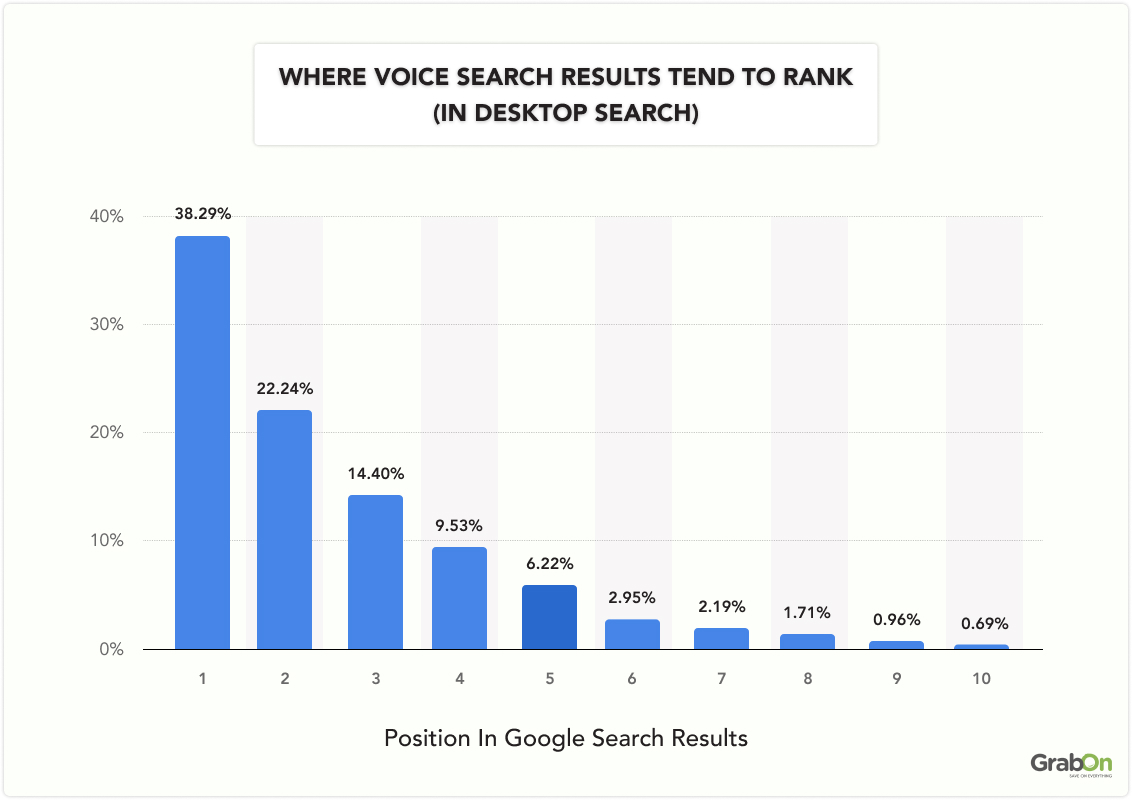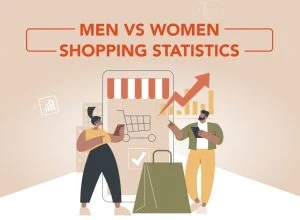Voice Search Statistics And Trends For 2025

Do you say 'Okay Google', 'Hey Siri', or straight-up 'Alexa'? Which is your preferred AI assistant? Whatever your pick, let’s face it: voice assistants have changed how we search today! With over 1 billion voice queries every month, it’s clear that people are talking more to their gadgets than ever before.
Voice assistants are part of our routine, with a booming voice shopping scene heading towards $40 billion and smart speaker sales climbing beyond $30 million units. It’s the voice of the future, and it’s speaking volumes. Read on to gain further insights into the top Voice Search Statistics of today and beyond!
Voice Search Statistics 2025 (Top Picks)
- 153.5 million people use voice search assistants worldwide.
- Over 1 billion voice searches take place over the internet every month.
- More than 50% of adults use voice search daily, especially when alone.
- The number of digital voice assistants worldwide is expected to exceed 8.4 billion, which is more than the human population in 2025.
- 58% of consumers use voice search to gather information about local businesses.
- Businesses that optimize Google My Business listing are 70% more likely to receive location-based inquiries through voice assistants.
- The global speech and voice assistant market is predicted to reach $73.49 billion by 2030, with an annual CAGR of 27.6%.
How Many People Use Voice Assistants?
153.5 million people use voice assistants as of 2025, up by 2.47% compared to last year. Voice assistant users are forecasted to grow at a steady rate of 4.87% and reach the 157.1 million mark by 2026.
The table below shows the number of voice assistant users over the years:
| Year | Number of voice assistant users |
| 2017 | 79.9 million |
| 2018 | 103.9 million |
| 2019 | 115.2 million |
| 2020 | 128 million |
| 2021 | 132 million |
| 2022 | 142 million |
| 2023 | 146 million |
| 2024 | 149.8 million |
| 2025 | 153.5 million |
| 2026* | 157.1 million |
Source: Statista
Who Are the Primary Users of Voice Search?
The primary users of voice search are young adults aged 18-24, with about 59% using it heavily, and individuals aged 25-49, with around 65% usage. Additionally, voice search adoption is growing among those over 50, with over 57% being heavy users.
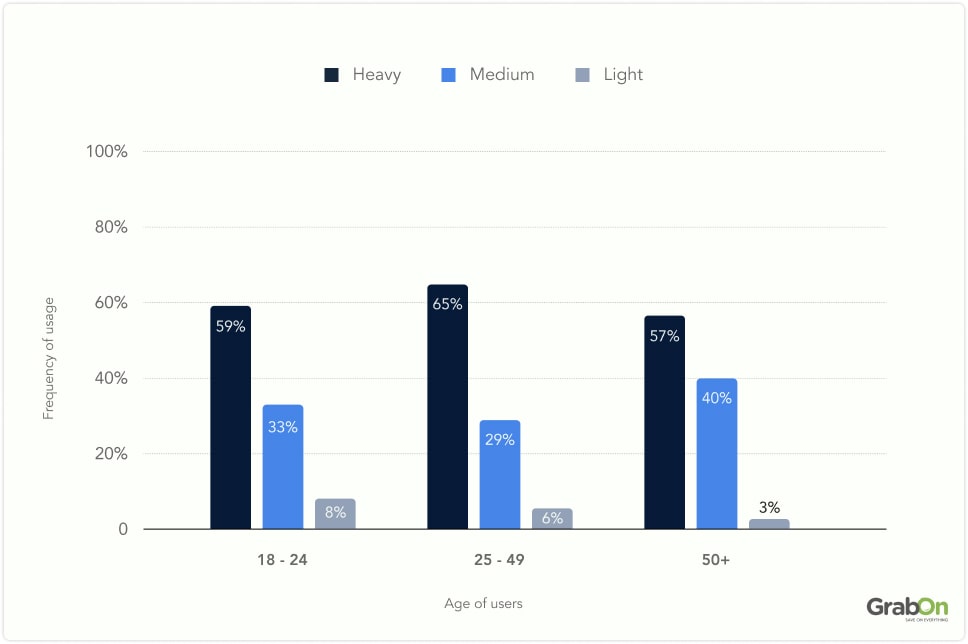
Source: PwC
Voice Search Usage By Country
Across all countries, weather-related searches were the most frequently performed with voice assistants, with U.S. and German users being the most avid to do so. Meanwhile, more than half (52%) of U.S. consumers surveyed used a voice-activated search for food delivery, compared to 41% in the U.K. and 36% in Germany.
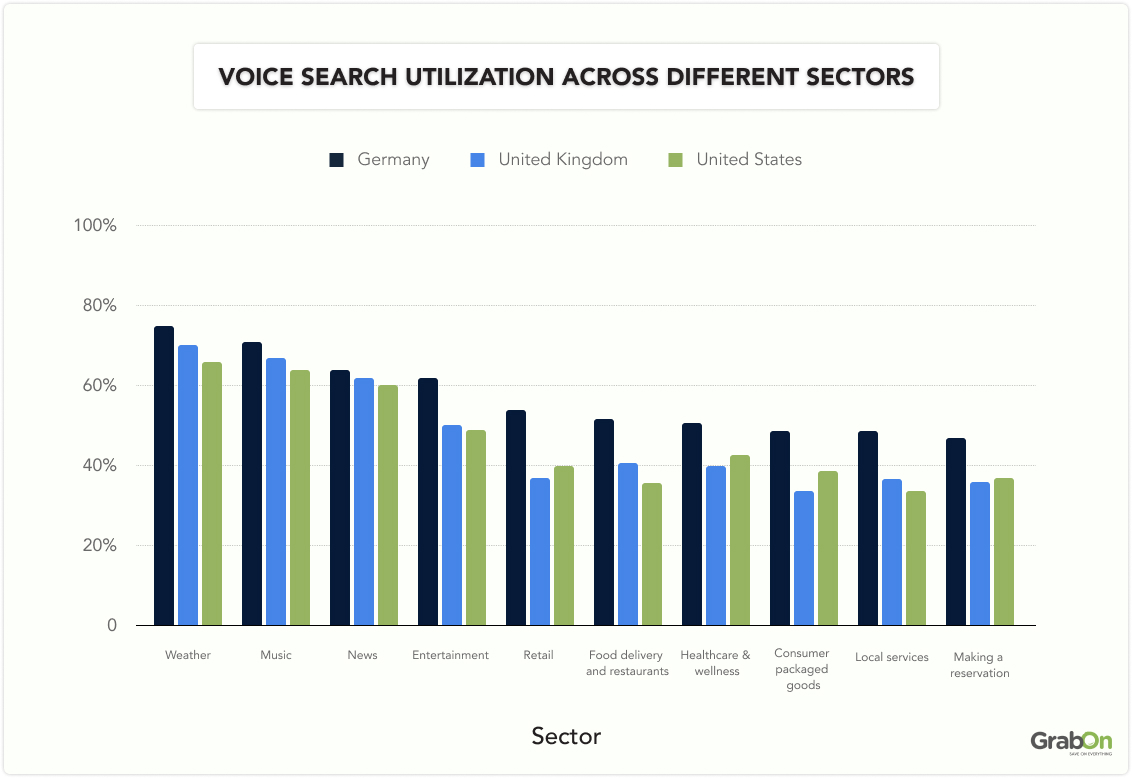
Source: Statista
Voice Search Usage By Age and Device
77% of adults aged 18 to 34 prefer conducting voice searches using their smartphones, with 63% of individuals aged 35 to 54 also favoring this device. When it comes to desktops or laptops, 38% of the younger demographic (18 to 34) opt them for voice searches, while 32% of the 35 to 54 age group find them suitable.
Tablets are also a favored device for voice queries among both age groups, with 37% of those aged 18 to 34 and 32% of those aged 35 to 54 using them for this purpose.
The table below shows the voice search usage patterns across various devices and age groups:
| Device | 18 to 34 Years | 35 to 54 Years | 55 Years + |
| Smartphone | 77% | 63% | 30% |
| Desktop/laptop | 38% | 32% | 15% |
| Tablet | 37% | 32% | 9% |
| Smart speaker | 34% | 19% | 4% |
| Considering voice search | 15% | 24% | 33% |
| Opposed to voice search | 9% | 12% | 30% |
Source: DemandSage
How Often Do People Use Voice Search?
People use voice search approximately 1 billion times every month More than 50% of adults use voice search daily, and 60% of users often use voice search when they are alone.
The table below highlights the percentage of users who use voice search in various situations:
| Environment | Percentage of Users |
| Home alone | 60% |
| Home with friends | Over 50% |
| Office alone | Around 50% |
| Restaurants with friends | Over 40% |
| Office with coworkers | Over 30% |
| Gym | Over 30% |
| Party | Over 30% |
| Restaurant alone | Over 30% |
| Public transportation | 30% |
| Restaurants with acquaintances | Over 20% |
| Public restroom | Over 20% |
| Theater | Over 20% |
Source: DemandSage
Voice Search For Local Businesses
Voice searches on mobile are 3 times more likely to be for local information compared to text searches. In fact, 58% of consumers have used voice search to find information about local businesses.
On a daily basis, 46% of all voice searches are for local businesses, with an additional 28% of users performing local business searches weekly.
The table below shows how often people use voice search to find information on local businesses:
| Frequency of Usage | Share of Respondents |
| Daily | 46% |
| Weekly | 28% |
| Monthly | 9% |
| Quarterly | 7% |
| Yearly | 10% |
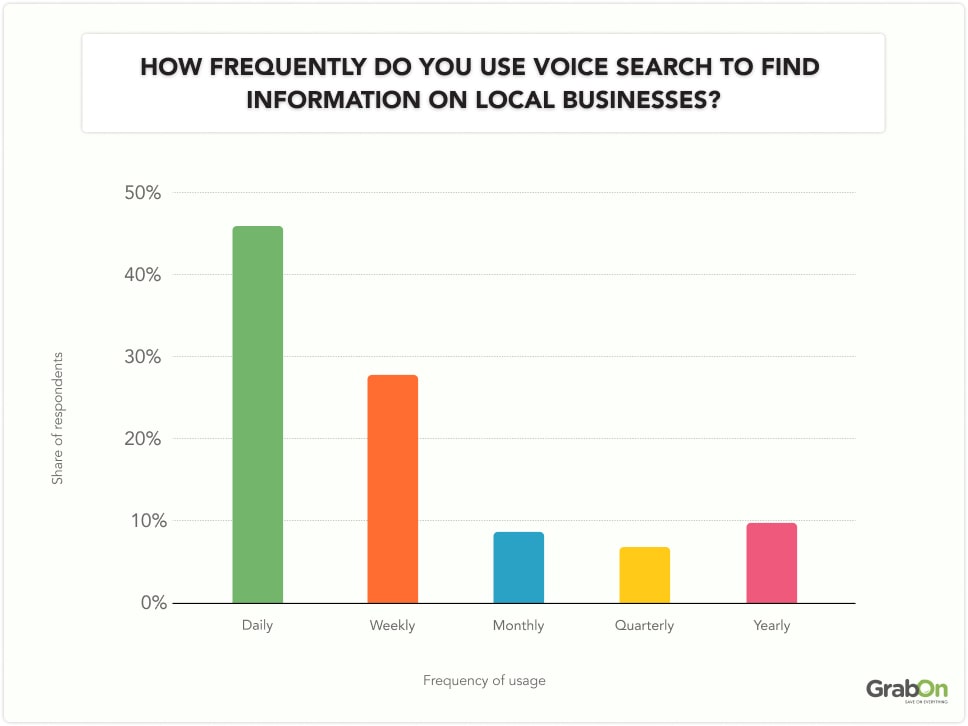
Source: BrightLocal
Local Businesses Found Through Voice Search
Location-based voice searches are essential for businesses with multiple places, because more than 58% of users use voice search to find local businesses. Additionally, 27% visit the website of a local business after making a voice search. Restaurants are frequently searched by 51% of voice search users, while other popular industries include grocery stores, food delivery services, and clothing stores.
The table below shows the industries most frequently searched using the voice search feature:
| Industry | % of Consumers Using Voice Search |
| Restaurants / Cafes | 51% |
| Grocery Stores | 41% |
| Food Delivery | 35% |
| Clothing Stores | 32% |
| Hotels / Bed and Breakfasts | 30% |
Source: BrightLocal
How to Optimize Your Business for Voice Search?
72% of smart speaker owners use voice search to find information about local businesses, which shows the need to optimize your content for featured snippets and local keywords.
To optimize your business for voice search, you can complete your Google My Business Listing. Businesses with complete Google My Business listings are 70% more likely to attract location-based inquiries via voice search. Around 80% of all voice search queries are conversational, so optimizing your content for natural, question-based language is key.
Additionally, voice assistants can answer 93.7% of search queries accurately, so providing structured data and clear answers will increase your chance to be featured in voice results.
Source: Uberal Voice Search Readiness Report, Think With Google
How Many Voice Assistants Are Currently in Use?
By the start of 2025, there will be more than 8.4 billion voice assistants in use,
surpassing the world’s population. This represents a 113% increase from the 4.2 billion devices in 2020.
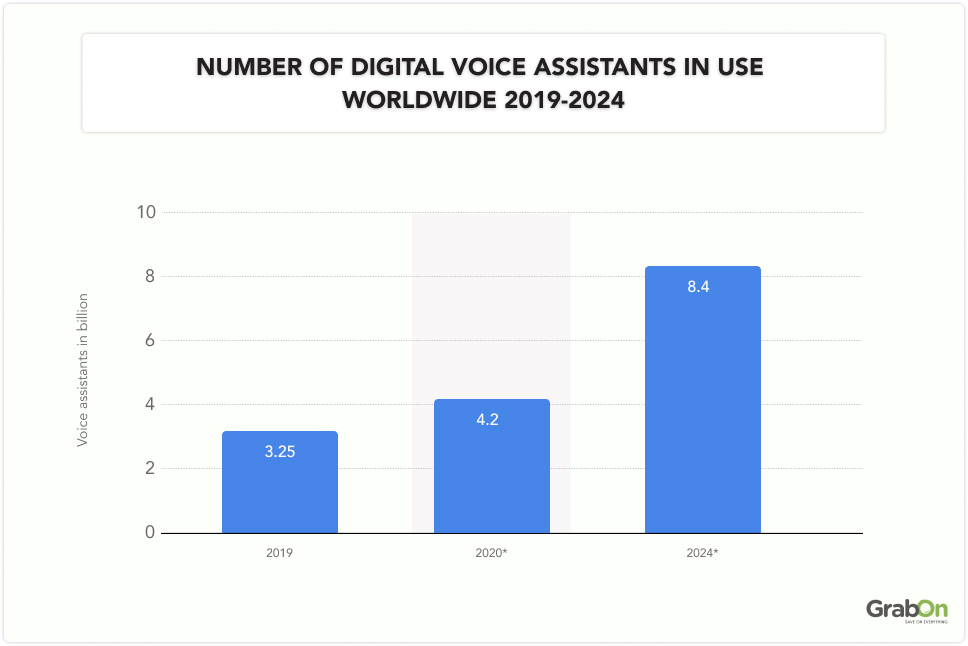
Source: Statista
Accuracy of Voice Assistants
Voice assistants are known for their high accuracy, with an average of 93% correct answers to search queries. However, their consistency across different devices is only 22%. Google Assistant understands queries perfectly 100% of the time and provides correct answers 92.9% of the time. Siri and Alexa both understand queries over 99% of the time but have slightly lower accuracy rates.
Refer to the table below to see how different voice assistants understand and correctly answer queries:
| Voice Assistant | Understood Query | Answered Correctly |
| Google Assistant | 100% | 92.9% |
| Siri | 99.8% | 83.1% |
| Alexa | 99.9% | 79.8% |
Source: Statista
Market Share of Voice Assistants
Apple's Siri and Google Assistant lead the digital assistant market, each capturing the attention of 36% of users globally. Amazon Alexa follows with a 25% usage rate, while Microsoft Cortana is utilized by 19% of users.
Here is a table showing the market share of voice assistants:
| Voice Assistant | Market Share |
| Apple’s Siri | 36.00% |
| Google Assistant | 36.00% |
| Amazon Alexa | 25% |
| Microsoft Cortana | 19.00% |
| Other | 1.00% |
Source: Statista
Voice Recognition Market Growth
The voice recognition market is projected to be valued at $18.39 billion in 2025 and is expected to grow to $51.72 billion by 2030, with a compound annual growth rate (CAGR) of 22.98% during the forecast period.
Source: Mordor Intelligence
Smart Speakers Revenue Over The Years
The global smart speaker industry is currently valued at $22.09 billion as of 2025. Between 2025 and 2029, the revenue in the 'Smart Speakers' segment of the consumer electronics market is projected to increase by $7.56 billion, a growth rate of 34.23%.
This growth continues the trend of consistent revenue increases in this segment for over a decade. By 2029, the revenue is expected to reach $29.65 billion.
Review the table below to see the projected revenue growth from 2019 to 2029:
| Year | Revenue (USD) |
| 2029* | 29.65 billion |
| 2028* | 27.81 billion |
| 2027* | 25.93 billion |
| 2026* | 23.99 billion |
| 2025 | 22.09 billion |
| 2024 | 20.18 billion |
| 2023 | 18.27 billion |
| 2022 | 16.13 billion |
| 2021 | 13.74 billion |
| 2020 | 10.62 billion |
| 2019 | 7.64 billion |
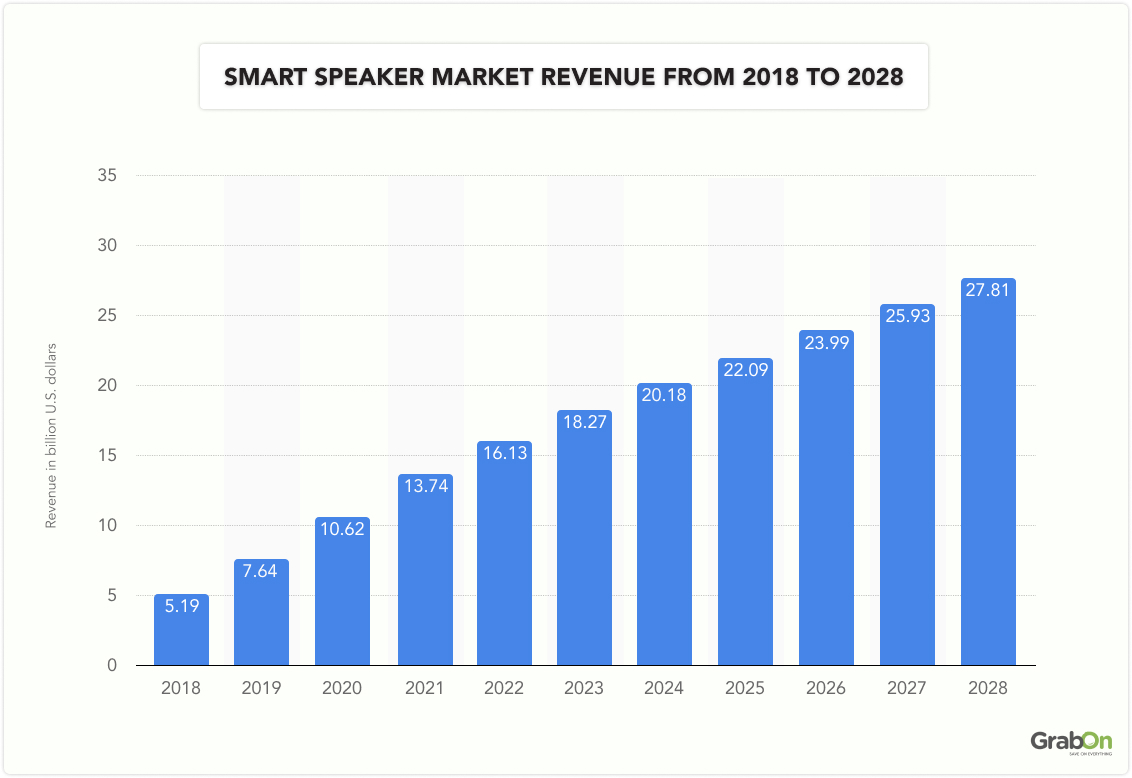
Source: Statista
Voice Commerce Statistics
The global voice commerce market reached $108.33 billion in 2024 and is projected to skyrocket to $586.3 billion by 2031, reflecting a robust CAGR of 27.28%. Notably, 80% of consumers who have made purchases using voice assistants report being satisfied with their experience.
At this growth rate of 27.28%, the global voice commerce market is expected to reach about $137.89 billion by 2025.
The table below shows items purchased via voice search and future purchase considerations –
| Items Purchased Using Voice Search | Have Purchased Items | Would Consider Purchasing In The Future |
| Food | 34% | 35% |
| Groceries | 31% | 27% |
| A book | 24% | 23% |
| Homecare items, electronics | 22% | 26% |
| Transportation | 21% | 29% |
| Reservation | 16% | 32% |
| Clothing | 3% | 22% |
| Travel reservation | 0% | 26% |
Source: PwC
How Are Voice Assistants Used for Daily Shopping?
Currently, 23% of consumers make regular purchases through voice-activated smart home devices such as Amazon Echo or Google Home. Additionally, 19% have used smart assistants to order, with most of the sales coming from the younger generation like GenZ.
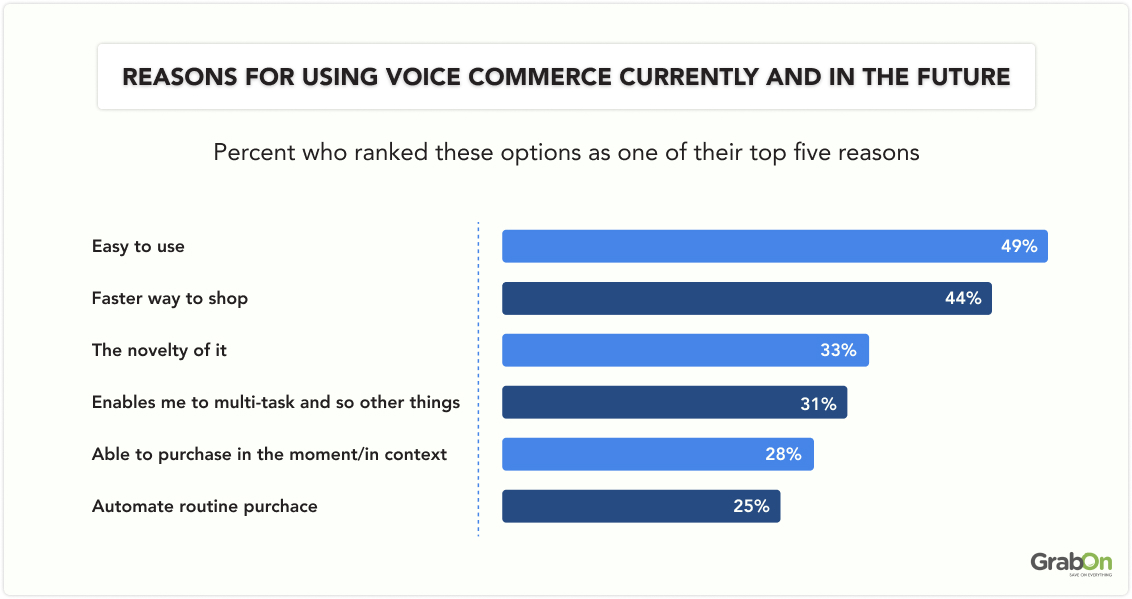
Source: OmniaRetail
Where Do Voice Search Results Rank?
Voice search on Google Assistant heavily relies on the top 3 results, which collectively offer 74.93% of the answers. Additionally, SERP features like Featured Snippets contribute significantly, providing about 70% of voice search responses. The typical voice search result to queries often give concise results, averaging only 29 words.
Interestingly, pages optimized for voice search tend to load 52% faster and have an average word count of 2,312, showing the importance of speed and content length in voice search optimization.
Check the table below to see the distribution of where voice search results tend to rank in desktop search:
| Position in Google Search Results | Share of Voice Search Results |
| 1 | 38.29% |
| 2 | 22.24% |
| 3 | 14.40% |
| 4 | 9.53% |
| 5 | 6.22% |
| 6 | 2.95% |
| 7 | 2.19% |
| 8 | 1.71% |
| 9 | 0.96% |
| 10 | 0.69% |
Emerging Trends in Voice Search
Voice search is taking off, especially among younger people, with Gen Z leading the charge. 64% of the US Gen Z population will use a voice assistant monthly in 2027, up from 51% in 2023. Google is in the driver's seat when it comes to voice assistants, pulling further ahead of competitors like Apple and Amazon.
You’re more likely to hear “Okay Google than “Hey Siri or “Alexa, and it shows Google Assistant is projected to have over 88.7 million users in the US by 2024. Looking ahead to 2025, that number is expected to rise to about 91.9 million, crossing Siri’s anticipated 86.5 million and Alexa’s 77.2 million.
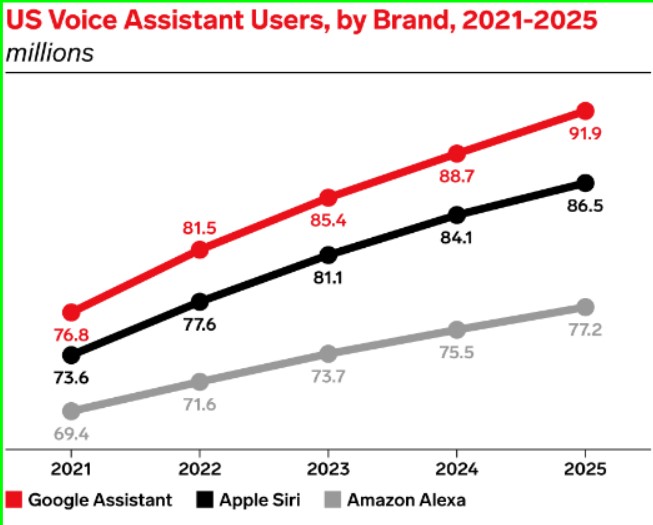
Source: EMarketer
Wrapping Up
The growing popularity of voice search, especially among the younger generation, is shaping the future of technology. It offers convenience and efficiency, leading to a significant rise in voice-based shopping, with projected revenues of $147.9 billion by 2030.
Smart speaker sales are also expected to exceed $30 billion. Looking ahead, voice assistants are set to become more emotionally intelligent, providing personalized responses and more human-like interactions. This evolution highlights the increasing importance of voice search in technology engagement.
